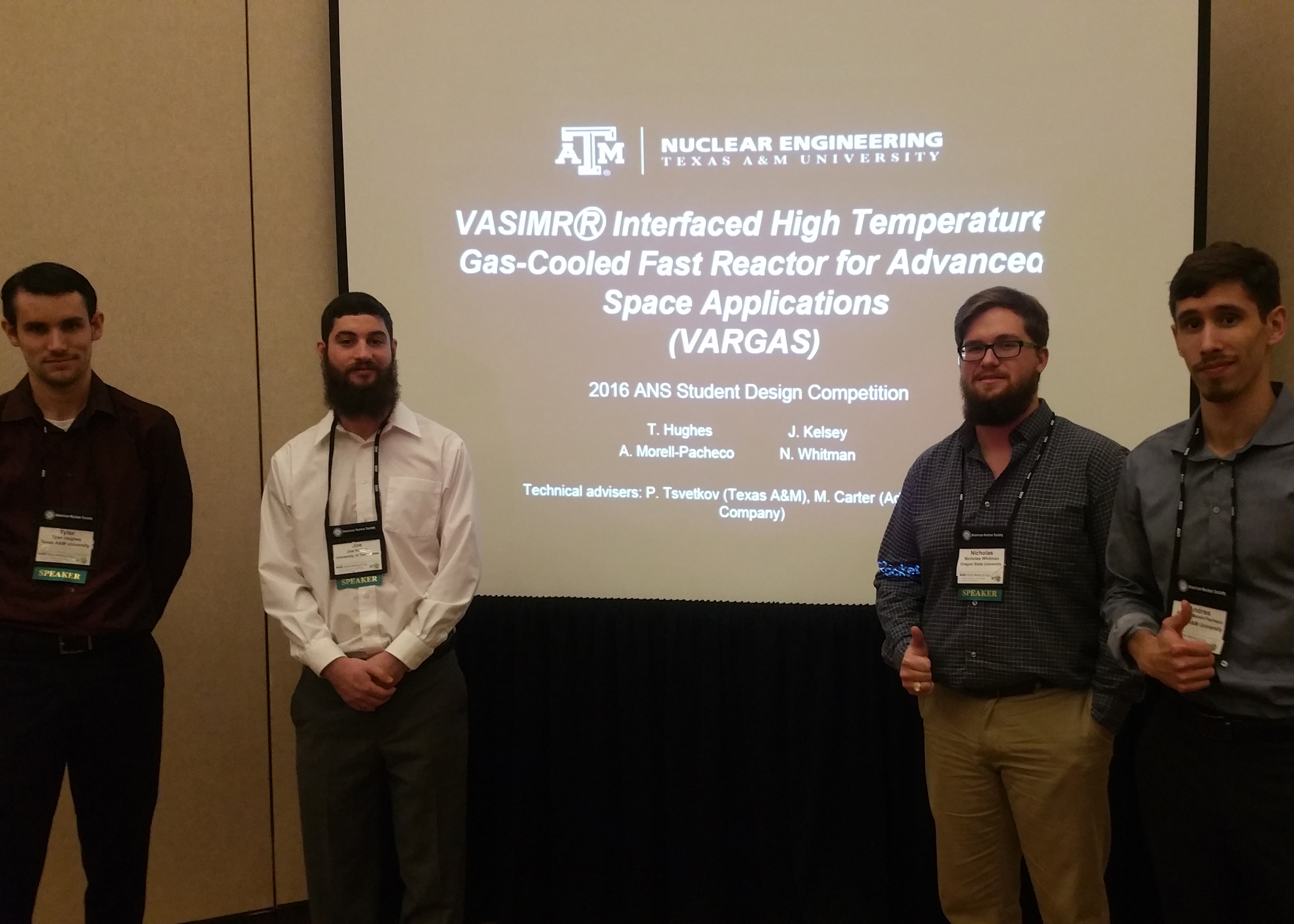
Students from the Department of Nuclear Engineering at Texas A&M University took second place in the 2016 American Nuclear Society (ANS) National Design Competition during the 2016 American Nuclear Society Winter Meeting and Nuclear Technology Expo in Las Vegas. The four-person team collaborated on a nuclear reactor design for a deep space exploration mission to Europa, one of the moons of Jupiter, partnering with an adviser from Ad Astra Rocket Company.
The team consisted of students Joe Kelsey, Tyler Hughes, Andres Morell-Pacheco and Nicholas Whitman. The team sought to couple a gas-cooled reactor as a power source for the Variable Specific Impulse Magnetoplasma Rocket (VASMIR) created by Ad Astra, while meeting the power concerns of the system and accounting for variables that would affect performance in space.
“The idea was that using the new capabilities that VASIMR offers, coupled with the high-density power source of nuclear power such a mission could be feasible,” Kelsey said. “Europa was chosen because it is one of the few locations in the solar system that could possibly support extraterrestrial life having large reservoirs of water beneath the frozen crust.”
The team determined the trip would be feasible because the VASMIR system has promising advantages in fuel efficiency.
“The VASIMR system, when paired with the appropriate power source, is able to generate thrust at higher exit velocities and thus more efficiently than conventional chemical rockets,” Pacheco said. “When paired with a highly-efficient nuclear power source, a VASIMR driven rocket system could be used for an efficient alternative to chemical propulsion and solar powered propulsion systems.”
For researchers, this translates to quicker access to deep space research materials and opportunities in a shorter amount of time, in addition to shortening overall mission timelines. For comparison, traditional chemical fuel sources could achieve travel to Mars in six months, where a plasma-based rocket powered by nuclear fuel could achieve the same distance in less than 40 days. Hughes, who helped develop the thermal hydraulic model for the team’s reactor, explains that while nuclear applications have been applied to space travel before, the team saw a greater range of capabilities with the VASMIR system, despite the challenges.
“One critical issue pertaining to the use of the VASIMR is the need for a reliable electric power supply, “Hughes said. “This power supply needs to be near one megawatt to achieve the amount of propulsion necessary to be competitive with travel times achievable by traditional chemical rockets. We believe the VASIMR system is one of the most promising technologies developed to achieve manned space missions in reasonable travel times. Nuclear power has been applied to space systems before, but previous space reactors have not provided nearly the amount of power required by the VASIMR system.”
The students conducted the project as part of their senior capstone course on nuclear design, taught by Dr. Karen Vierow Kirkland, associate department head and associate professor, who designed the course to encourage participation in, and meet the requirements of, the competition. According to Kirkland, the teams face more than just technical challenges.
“One of their learning experiences in the senior design course is to have regular team meetings while working around peoples' schedules,” Kirkland said. “People have to work together, share data and promote each other. These are something I like to call group dynamics issues, which present challenges to working together and creating a unified team and collective project.”
While this project only delved into a theoretical design, it still displays an opportunity for the professional development of the students and a demonstration of their expertise.
“I think it was very beneficial to participate in this competition,” said Whitman, who was responsible for designing the nuclear reactor core. “It gave us a very good opportunity to get feedback and criticism for our project.”
In addition to presenting their work at the competition, the students are also required by Kirkland to display their work in front of the department faculty, advisory council members and others in industry to demonstrate their grasp of their work. Design teams from Texas A&M have either won or been competition finalists four times in the last six years, something Kirkland attributes to the exceptional quality of the students and rigor of the course.
“I think that this says our students are highly regarded by the technical community,” Kirkland said. “This design competition is a national competition. None of our faculty are organizers at this competition so our teams are being chosen by other technical experts who are evaluating a large number of teams. I think that speaks very highly of our teams in terms of technical competency and teamwork.”